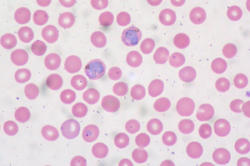An ancient remnant inside the malaria parasite
Posted on March 23, 2016 by Anand Jagatia
Today at the Society’s Annual Conference, Dr Ellen Nisbet talked about the malaria parasite Plasmodium, and how a remnant from its evolutionary past may one day provide a target for new drugs…

Malaria is caused by protozoan parasites of the Plasmodium genus. These parasites are transmitted via mosquito bites, and several different species are known to infect humans. But look inside a Plasmodium cell itself and you find something rather unexpected – a cellular structure that looks remarkably like a chloroplast.
These apicoplasts, as they are called, are remnant chloroplasts, a leftover from Plasmodium’s evolutionary past. Apicoplasts – unexpectedly discovered in the malaria parasite about 20 years ago – have long since lost the ability to carry out photosynthesis, but they remain essential for Plasmodium’s survival. Without them, the parasite would die.
“The apicoplast seems to be involved in pathways for haem and fatty acid biosynthesis,” explains Ellen. “So while they don’t do a huge amount, Plasmodium can’t fully lose the organelle. It’s stuck with it, a bit like an evolutionary dead end.”
Chloroplasts were once free-living photosynthetic cells known as cyanobacteria. At some point in the history of early life, a cyanobacterium was engulfed by another cell. It eventually lost many of its own genes and was no longer able to survive on its own.
The story doesn’t end there. The ancestor of Plasmodium in turn engulfed another cell that already had a chloroplast. The other elements of this cell were discarded, but the chloroplast was maintained for photosynthesis. In some relatives of Plasmodium, like the dinoflagellates (microbes that live inside corals), the ability to carry out photosynthesis was kept. And in others, like the parasite Cryptosporidium, the apicoplast was lost again.
Ellen’s group has been researching how the genetic material inside the Plasmodium apicoplast is read, known in genetics as transcription. Transcription involves converting sections of DNA into a related molecule, called RNA, so that it can be decoded by the cell and turned into proteins (a process known as translation).
The Plasmodium apicoplast has lost all the genes encoding proteins for photosynthesis, and those that remain are found on a single circle of DNA. But some of these genes overlap, so simply reading out the sequence and cutting it into pieces (known as ‘cleavage’) wouldn’t give you readouts for separate, distinct genes. Something more complex seems to be going on.
“It’s interesting to see how different things transcribe themselves, so a lot of what we’re doing is out of sheer curiosity,” says Ellen. “How does a genome use overlapping genes? And more long-term – how are these processes happening? What’s driving transcription, what’s driving cleavage, and what proteins are involved?”
In the future, research on the apicoplast could also lead to new drug targets against the malaria parasite. “There are anti-malaria drugs out there involved in inhibiting the translation machinery, and these are in common usage,” says Ellen. “But there aren’t very many that target the transcription process. So if we could inhibit transcription, and post-transcriptional processing pathways, maybe that could provide us with new antimalarials.”
